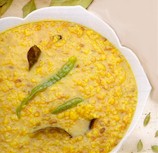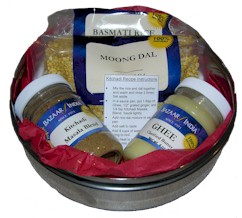
![]()
| 1 cup | basmati or brown rice |
| 1 cup | moong dahl (yellow lentils) or split mung beans |
| 2 T. | clarified butter |
| 1 t. | black mustard seeds |
| ½ t. each | cumin, dill, fennel, ajwan (wild celery), and fenugreek seeds |
| 1 | medium size onion (chopped) |
| 7 | cloves of garlic (finely chopped) |
| 1" | ginger root (grated or finely chopped) |
| 1 t. | turmeric |
| 3 | green or black cardamom pods (cracked) |
| 2 | small red chilies (or ¼ t. cayenne) |
| 3 | cloves |
| 3 | bay leaves or a pinch of neem leaves |
| ½ t. | coriander seeds |
| ¼ t. | cinnamon bark chips |
| pinch | saffron |
| ¼ t. | black salt |
| pinch to ¼ t. | asafoetida |
| vegetables to taste: peas, carrots, cauliflower, leeks, burdock root |
![]()
Instructions
Melt the clarified butter in a large pot. Add the mustard seeds, cover the pot, wait for the seeds to pop. Add the seeds, sauté lightly. Dice the onion and sauté until translucent. Add the garlic and ginger, sauté a little longer. Add the rice and lentils (pulses) and cover with water twice the depth of the rice and lentils. Bring to a boil, then reduce the heat. Add the powdered spices (turmeric, cayenne) and the coriander, cinnamon, bay or neem leaves, saffron, cloves, and cardamom. After ten minutes, add those vegetables which take longer to cook (burdock root, cauliflower, leeks, or carrots). After another half an hour, add the peas and asafoetida. When the lentils are tender, add the salt. For extra taste, add a bouillon cube (if salted, wait until the end). For extra energy, use a few pieces of astragalus or kombu. Be sure that the spices are not irradiated, but do not worry if you are missing some of the ingredients. It will taste just fine if you have some or most of the spices. Bon appetit!
For variety: make the dish with different vegetables and spices and adjust the texture somewhere on the spectrum between soup and pilaf.

Special package containing 8 oz. of basmati rice, 8 oz. of moong dal, spices, and 4 oz. of ghee. Includes the beautiful stainless steel container (with lid and festive wrapping) and instructions for making the kicharee.
Warning:
Be sure to use non-irradiated spices. Good spices should be fresh, aromatic, and free of pesticides, irradiation, and signs of processing. The oils inherent in spices act as stimulants to the salivary glands and gastrointestinal system. They relieve gases and promote better assimilation of nutrients and good peristalsis.

See the article on taste and the elements:


Poulsbo, Washington
Copyright by Ingrid Naiman 2007 and 2014